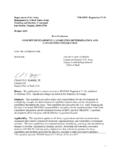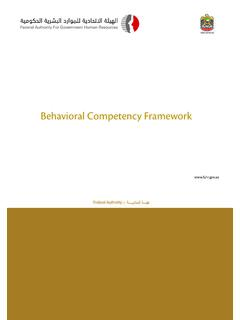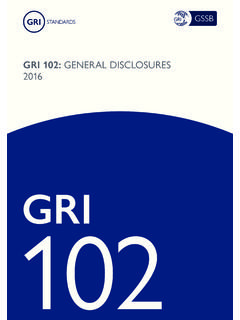Transcription of UNITED STATES ARMY TRAINING AND DOCTRINE …
1 UNITED STATES army TRAINING AND. DOCTRINE COMMAND. NCO 2020 Strategy NCOs Operating in a Complex World 04 December 2015. Contents Part I, Introduction Part II, Strategic Vision Part III, Ends, Ways, and Means Part IV, Conclusion Appendix A: NCO 2020 Strategic Framework Appendix B: NCOPDS. Appendix C: Sources 2. Part I Introduction Introduction Leader development is fundamental to the readiness of our army . This Noncommissioned Officer 2020 Strategy (NCO 2020) provides vision and guidance on ends, ways, and means for developing NCOs that exercise Mission Command while planning, preparing, executing, and assessing Unified Land Operations to meet the challenges of the 21st Century and preserve the combat readiness of our force. NCOs must understand the strategic environment, be able to think critically and creatively, visualize solutions, and describe and communicate crucial information to achieve shared understanding, collaborate, and build teams.
2 Leader development is the deliberate, continuous, and progressive process founded in army values that grows Soldiers and army Civilians into competent, committed professional leaders of character. Leader development is achieved through the career-long synthesis of the TRAINING , education, and experiences acquired through opportunities in the institutional, operational, and self-development domains, supported by peer and developmental relationships. In the decade following 2015, the NCO Corps must evolve its Noncommissioned Officer Education System (NCOES) to focus on ways to optimize human performance. A key part of this will be the evolution and expansion of the NCOES into what will be the NCO Professional Development System (NCOPDS). The NCOPDS will serve as the vehicle to operationalize the concepts and lines of effort as outlined in this strategy.
3 To be successful we must strategically shape new policy, leverage innovation, and focus on closing performance gaps using an organized framework and establishing achievable milestones. The NCOPDS represents a transparent and grounded approach to managing future changes in the way the army trains and develops Soldiers. As a strategy it is intended to support imperatives related to the army profession, Mission Command DOCTRINE , human performance optimization, and overall combat readiness of the force. The NCO 2020 strategy is focused on creating a production system that provides NCOs with access to developmental and broadening experiences needed both in garrison and within the operational environment. The most enduring legacy that we can leave for our future generations of noncommissioned officers will be leader development.
4 -SMA Julius W. Gates 3. Part II Strategic Vision Vision A cohort of competent and committed Noncommissioned Officers of character as trusted army professionals who thrive in chaos, adapt, and win in a complex world. A professional, trained, and prepared NCO Corps is central to the army 's ability to remain ready as the world's premier combat force. Part III Ends, Ways, and Means Ends A Noncommissioned Officer Professional Development System (NCOPDS) integrated and synchronized in the development of the next generation of competent and committed NCOs of character as trusted army professionals capable of thriving in chaos, adapting and winning in a complex world. From a deliberate, data-driven analytical process, examining the current model of developing NCOs using The army Leader Development Strategy, the Enlisted Desired Leader Attributes for Joint Force 2020, the army Learning Concept and the army Learning Model, the NCOES evolves into an integrated NCOPDS.
5 This approach will ensure the NCO Corps is prepared to fight and win our nation's wars and enhance overall readiness of our army while remaining consistent with the NCO Corps vision. Desired end state includes: providing the army a more adaptable, resilient NCO Corps;. improving the professionalism of the NCO Corps; improving TRAINING and education expertise in the NCO Corps; providing challenging, relevant and rigorous leader development TRAINING , education and experiences; articulating learning responsibilities and requirements across the three learning domains and integrating them into a synchronized, effective and efficient development system; improving professional development models and learning curriculums so that Soldiers and leaders can assess leader development progress, track learning events, create goals and certify professionals; supporting the identification and development of NCOs to serve at operational and strategic levels; army , commanders and NCOs are satisfied with development programs and performance.
6 Policy, DOCTRINE and programs fully support a lifelong learning environment and support the needs of both active and reserve organizations and Soldiers. Ways Central to this strategy is that leaders at all levels understand their responsibility for continually developing other leaders. army senior leaders set conditions for the army to develop NCOs by teaching them, TRAINING them, and providing the supporting experiences they need to grow as leaders. Additionally, leaders help individuals realize that commitment to career-long learning is essential to development, as well as, maintaining readiness of the force. The NCOPDS will adhere to seven leader development imperatives that will guide policy and actions in order to develop NCOs with the required qualities and enduring leader characteristics.
7 These guiding principles remain constant and consistent from initial entry into the army to transition creating a leader development continuum that is deliberate, continuous, and 4. progressive. These imperatives will drive the synchronization and implementation of the NCO. 2020 Strategy: Commitment to the army Profession, lifelong learning, and development. Balance the army 's commitment to the TRAINING , education, and experience components of leader development. Manage talent to benefit both the institution and the individual. Select and develop leaders with positive leader attributes and proficiency in core leadership competencies for responsibility at higher levels. Prepare adaptive and creative NCOs capable of operating within the complexity of the operational environment and the entire range of military operations.
8 Embed Mission Command principles in leader development. Value a broad range of leader experiences and developmental opportunities. To achieve the desired strategic ends, the Noncommissioned Officer Education System (NCOES) must fundamentally change and evolve into a comprehensive leader development process that links TRAINING , education, and experiences spanning the operational, institutional, and self-development learning domains. The NCO 2020 Strategy is organized into three distinct lines of effort: 1. Development. NCOs develop as leaders over time through deliberate progressive and sequential processes incorporating TRAINING , education, and experience across the three learning domains throughout the Soldier Lifecycle. 2. talent Management. The purposeful expansion of an NCO's core MOS proficiency and leadership provided through developmental positions, opportunities, and assignments both within and outside of their Career Management Field (CMF).
9 3. Stewardship of the Profession. Strengthen the NCO Corps by emphasizing the role of the NCO in building and sustaining trust; constantly improving military expertise; setting an example of honorable service; fostering a climate rich in esprit de corps; and serving as stewards of the army profession. These LOEs have several key supporting tasks associated with each: LOE#1: Development Our fundamental task is like no other- it is to win the unforgiving crucible of ground combat. -General Mark A. Milley LOE#1: Development. NCOs develop as leaders over time through deliberate progressive and sequential processes incorporating TRAINING , education, and experience across the three learning domains throughout the Soldier Lifecycle. 5. Major Objective : Select, Train, Educate, and Promote ( ).
10 Career Management Model Deferment Policy Promotions Policy Scheduling Priorities Major Objective : NCO Professional Military Education Integrated into army University Establish Level V PME (Master Leader Course). Incorporate NCO General Learning Outcomes (GLOs). Develop common NCO learning content Include nominative CSM/SGM PME. Curriculum rigor and relevance Structured Self Development (SSD). Instructor screening, selection, development, and recognition Optimize use of the One army School System (OASS). Joint Professional Military Education Major Objective : Credentialing Identify and validate credentials Resource examinations Facilitate credentialing process Major Objective : Validate, Record, and Track Digital Job Book army Career Tracker (ACT). Skills Qualification Test (SQT).







